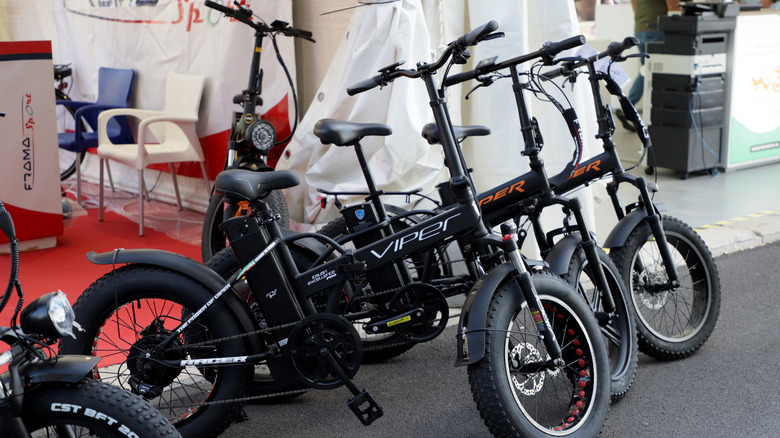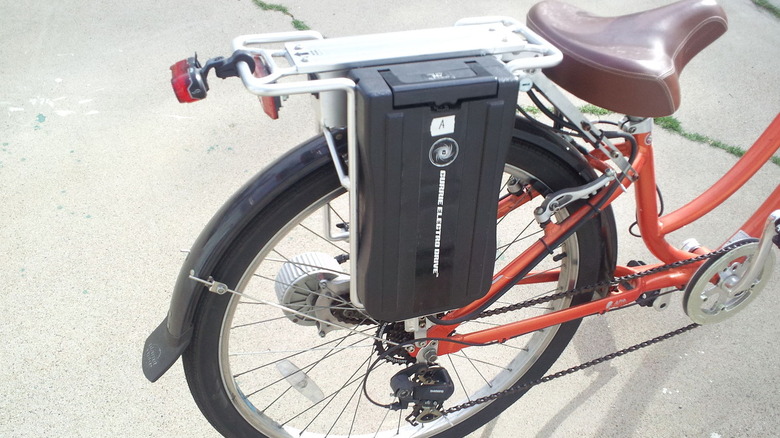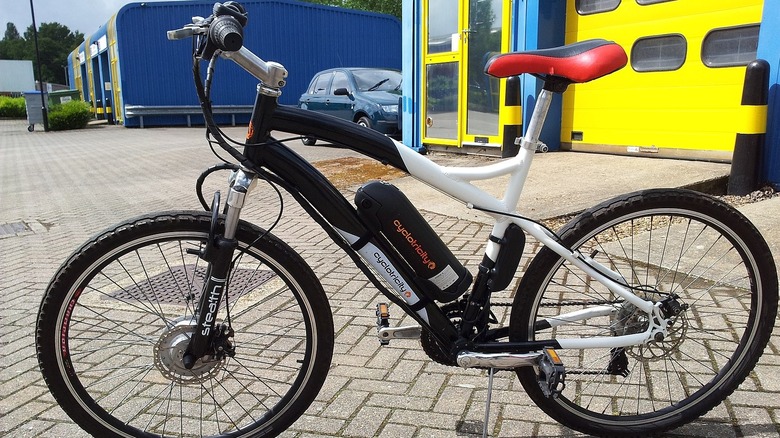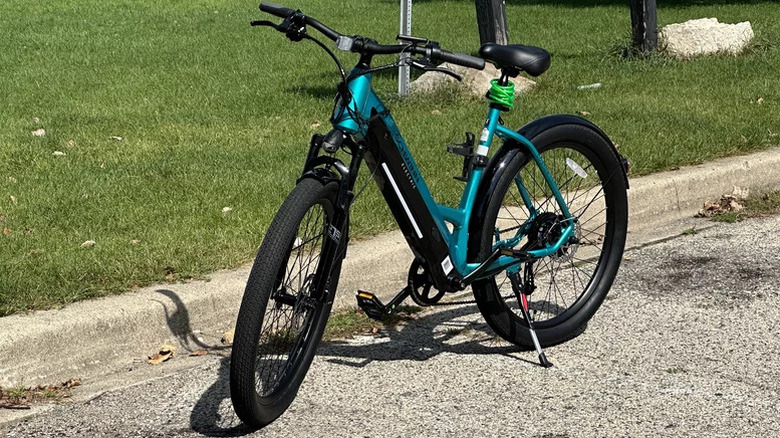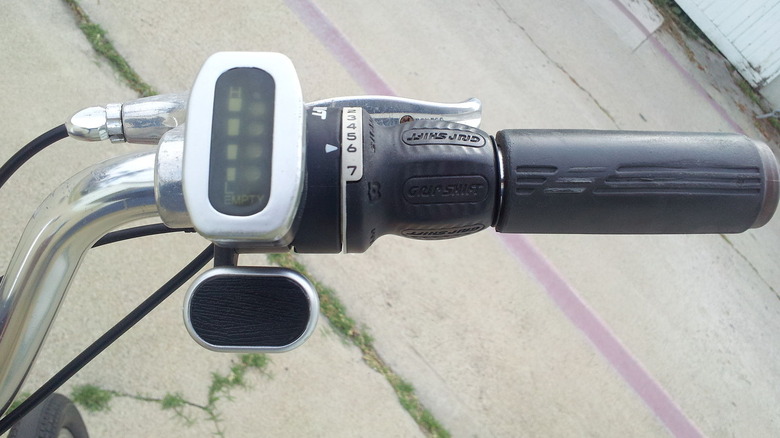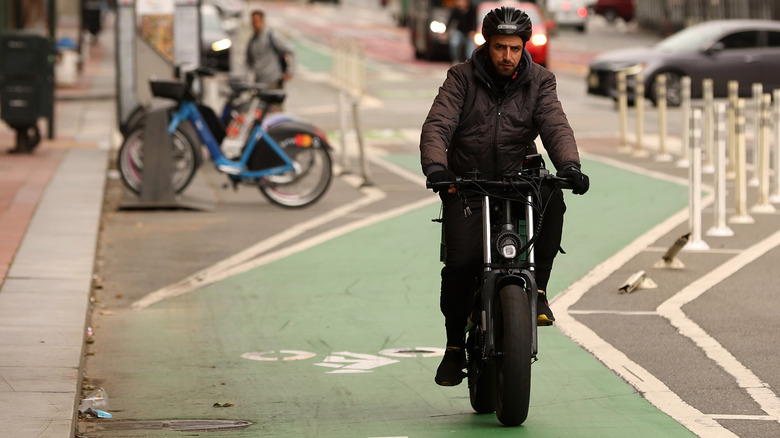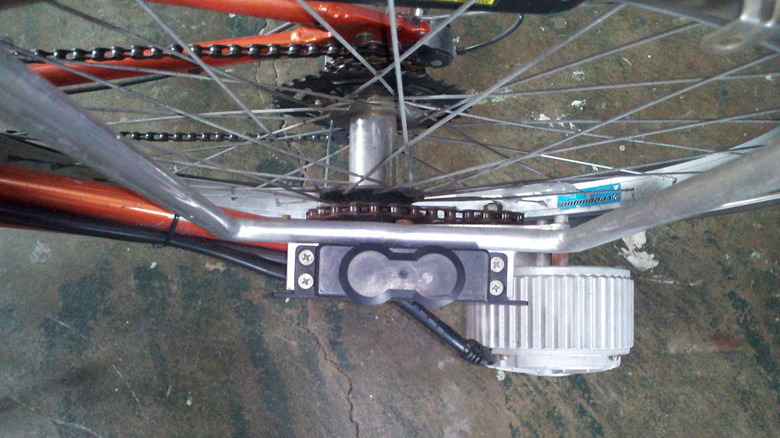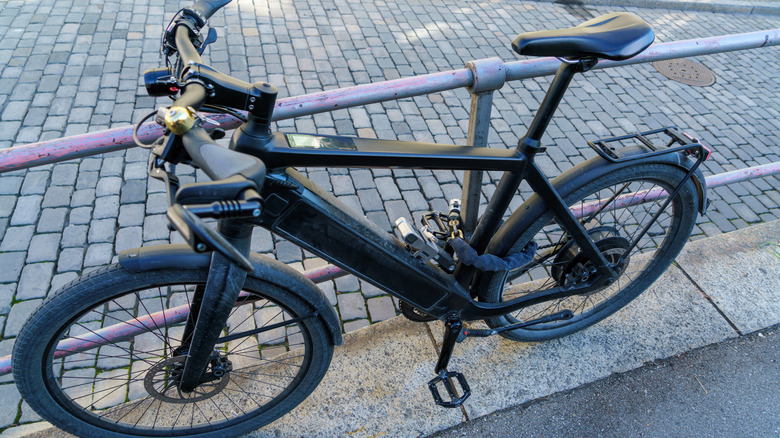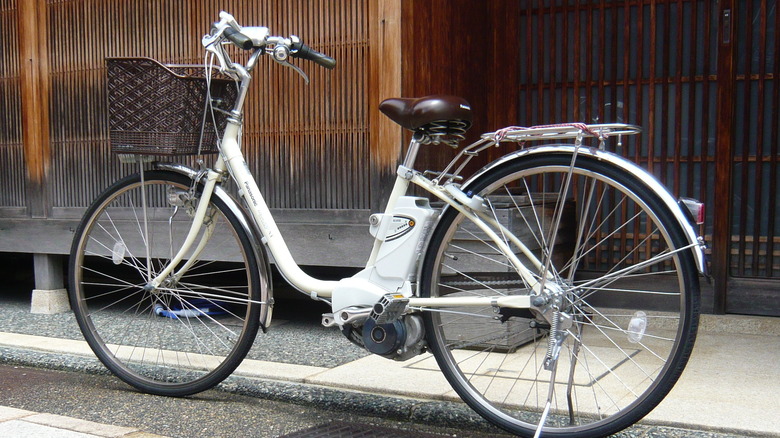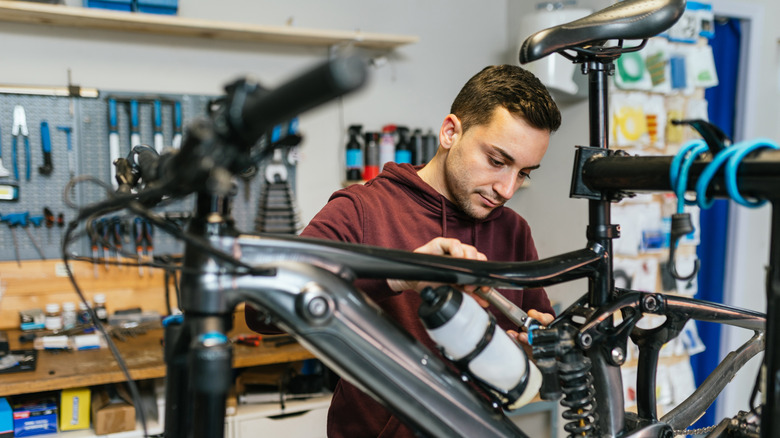10 Things You Should Know Before Buying An E-Bike (New Or Used)
Riding a bicycle is a great way to get exercise. It's far more active than simply sitting in a car, and many people have already discovered the benefits. And for anyone worried they may not be in good enough shape to pedal all of the time, there are ample eBike options to help them out.
Equipped with batteries and electric motors to assist the rider on a trip, eBikes still require pedaling, but the rider gets a boost, which is particularly useful when traveling a longer distance or needing to go uphill. Those who always thought riding a bike everywhere wouldn't be practical now have some extenuating factors to consider. Plus, it's even possible to learn how to turn a regular bicycle into an eBike with some handy conversion kits.
Ultimately, most people would do well to simply purchase a new or used eBike that was meant to have an electric motor. Numerous options are now on the market from a litany of first-class brand names. But whether you plan on going to a reputable store or purchasing one secondhand from someone else, it's critical to keep a few points in mind. An eBike is meant to make your life easier, so you don't want to get started on the wrong foot.
Check the battery condition
The battery is one of the most crucial components of an eBike, and what kind you have can factor into performance. Older eBikes usually have larger lead acid batteries (these tend to be more affordable), whereas newer models may have a lithium-ion battery. You can be fairly certain that a new bike will have a pristine battery ready to go, but when buying an eBike used, you should approach with more caution.
For the most part, eBike batteries last between 800 and 1,000 charge cycles. At that point, they may experience greater difficulty in holding charges. It may even fail completely shortly after purchasing it, and a new eBike battery can cost anywhere between $400 and $900 depending on the type of battery being used. Used eBikes typically don't come with the same level of paperwork as used cars, so the previous owner may not have exact figures to let you know how many times they've charged it already. In general, you can get an idea by asking about how long they've had the bike and how often they've used it.
Regardless or buying a new or used eBike, you'll want to check the battery's capacity. For example, SlashGear's review of the Swagtron EB-5 found that the battery could last up to 15.5 miles, so you'll want to consider how long you'll typically ride your bike before you'll be capable of charging it again.
[Featured Image by Stanistani via Wikimedia Commons | Cropped and scaled | CC-BY-SA-3.0]
Prices vary wildly
While eBikes naturally cost far less than a car, a litany of factors impact the price and they can be quite pricey depending on the type you get. A standard commuter bike meant for the city can be as low as $500 while going up to several thousand depending on the brand. However, anyone who wants a cargo eBike that comes with a more resilient construction to haul large loads generally start at around $2,000.
This is one reason why buying a used eBike make be more desirable than buying one new. As mentioned previously, buying a new eBike battery can cost just as much as the eBike itself in some instances, so you need to be certain you won't end up paying more in the long run.
Every bicyclist's needs will be different. Perhaps some newer features will make the extra cost worth it, but if you're just hoping to dip your toes into eBike riding, there are choices that won't break the bank.
[Featured Image by Michi2873 via Wikimedia Commons | Cropped and scaled | CC-BY-SA-3.0]
There are different classes of eBikes
The United States classifies electric bikes into three separate categories — Class 1 (Pedal Assist), Class 2 (Throttle Assist), and Class 3 (Speed Pedelec). The exact classification can vary, and it's possible for some eBikes to go between classes if any modifications are made. Ultimately, these classes determine how fast an eBike can go and where it can legally travel. Some states prohibit certain bikes from accessing street lanes, or may require licenses.
For example, the Schwinn Coston CE electric bike is a double-edged sword in many regards. It can be classified as either a Class 1 or Class 2 eBike, as the throttle is able to propel the rider up to 20 mph. At Class 3, an eBike would need to be able to get up to 28 mph, and at that point, many places will require a license and the driver to be at least 16 years of age.
Class 1 offers the widest scope of options because there are typically fewer restrictions. However, anyone wanting to go as fast as possible may want a Class 3. As with most things, you'll have to decide how you'll primarily use your eBike before purchasing it.
eBikes also come with one of two different brakes
Electric bikes come with one of two brake options. There will either be hydraulic brakes, which involves fluid running to the brake caliper to bring the bike to a stop, or mechanical brakes, which involve cables pulling on the caliper. Both are designed to halt your bike when you need to, and one isn't inherently better at it than the other. However, there are pros and cons to both to be aware of.
Mechanical brakes often require the cyclist to squeeze the handle harder to get it to stop faster, which may be more difficult for certain individuals. The upside is that maintenance in the long run tends to be more straightforward. In contrast, hydraulic brakes tend to require less maintenance since there's no cable involved, but when repairs become necessary, it quickly becomes more complicated due to the presence of those fluids. Either one works just fine for most cyclists, but it helps to know which one comes with the bike you're interested in just so you know what to expect down the road.
[Featured Image by Stanistani via Wikimedia Commons | Cropped and scaled | CC-BY-SA-3.0]
Know what size is right for you
It's easy to get excited when you see a eBike that looks really cool, but if you hop on to take it for a test drive and it doesn't quite feel right, listen to your body. A host of issues can develop if you regularly ride a bike that isn't the right size for you. You may injure yourself and put yourself in greater danger of a collision, so it's paramount to know your measurements before buying a new or used eBike.
Your height and inseam will let you know how large a bike frame to look for. It's possible you'll fall between a couple of different frame options, so the best thing is to try out a bunch of different bikes and see what feels right. Ideally, your knees shouldn't feel scrunched. You also don't want to feel as though you're overextending to get to the handlebars. You can always adjust the seat height, but if nothing quite feels right, it may be best to find something else.
Many electric bikes come with recommendations in terms of who can ride it. For example, the larger SWFT Fleet eBike only really works for individuals who are at least 5 foot, 7 inches tall. Similar to how test driving a car gives you a feel for whether it's right for you, it's a good idea to make sure you can pedal comfortably before buying a bicycle.
Look for availability of parts
It doesn't matter if you purchase a used eBike or one that's completely new. Sooner or later, you'll have to replace something if you ride it regularly. This is a natural part of bike maintenance, and you can save yourself a lot of trouble if you research what parts you may need for your particular bike before buying it.
This is simply a matter of researching the manufacturer parts and seeing where you can buy them. As long as you're buying a bike from a reputable brand, you shouldn't have much to worry about. Even Propella, which SlashGear ranked as one of the worst major eBike brands, still earned some compliments by having easily accessible components.
A product from a defunct eBike brand may put you in a bind later. If you can't get the exact same part, it's worth researching to see if anything else might be compatible with your bike, too.
[Featured Image by Stanistani via Wikimedia Commons | Cropped and scaled | CC-BY-SA-3.0]
Research safety materials
An eBike is a great investment, and any investment requires protection. For starters, you want to understand your purchase's warranty inside and out and be aware that if you're buying it used you probably won't get one at all. It's also vital to understand how to properly charge an eBike, because fires can break out from doing it incorrectly. Finally, even though you may be wary of spending even more money after dropping a pretty penny on an electric bike, it's worthwhile investing in some safety materials.
Regular bicycles are already major targets for thieves, and considering that eBikes can fetch a lot more money, they're prime targets, too. Naturally, you'll want to purchase a heavy-duty lock so that you can keep your vehicle secure if you go into a shop. It's also good to consider some kind of GPS tracker, like an AirTag, so if your bike is stolen, there's some hope you can still see where it is.
You even need to be mindful at home. It's recommended to keep your eBike in a safe location that's hard for strangers to get to. If you really want peace of mind, you can remove the battery when you get home. Someone can still ride off with the bike, but without the battery, it becomes far less attractive in terms of the thief trying to resell it.
Understand your warranty
Buying a new eBike means it'll likely come with a warranty of some variety; it's just a question as to how long it goes for. Typically, cheaper eBikes will have shorter warranties (perhaps one year) compared to more expensive models where the warranty extends for several years. It's even possible there will be several different warranties in play.
Check what's included in the warranty. The frame may have a completely different covered timespan than the battery. Certain components may be excluded entirely. As always, good maintenance will help keep the bike in good shape regardless if the warranty expires.
It's a good reminder that used eBikes generally don't include the initial warranty. Therefore, if you're buying something from a private party, it would be in your best interest to speak with the seller about repairing anything off before you exchange any money.
[Featured Image by HAL-Guandu via Wikimedia Commons | Cropped and scaled | CC BY SA 4.0]
Familiarize yourself with eBike maintenance
Since electric bikes have more components than standard bicycles (like the battery and possibly an onboard computer), there's a good chance yours will require more maintenance than you may be used to. You may be able to find an eBike repair shop near where you live where you can take it in once every few months to make sure everything's working as it should. But you can save yourself money and hassle by learning how to take care of some basic eBike maintenance on your own.
As far as extending battery life, it's a good idea to maintain a healthy charge. You should avoid completely draining your battery every single time before plugging it in again, so even if you went on a short trip, it's a good idea to top off if you're able. You can ride on Eco mode if possible, and it's recommended to keep your bike stored in a location where it won't get too cold during the winter, as that can prematurely drain the battery.
You also won't go anywhere if you get a flat tire, so make sure to check the pressure regularly. If you don't already know how to repair a flat while on the road, it'd be a good time to learn. Most of all, you should pay attention to any changes in your bike's performance and if you begin hearing any strange noises. Get those issues rectified promptly or else you could deal with a worse (and more expensive) problem later.
Know your state and local eBike laws
After reading through all this, you may decide an eBike sounds great. Thanks to the internet, you can even order whatever electric bike you want online and have it delivered to you with your precise specs. But before you get too happy, check your local and state laws to see if there are any eBike restrictions to follow.
Some states abide by the previously mentioned class system, where Class 1 and 2 don't require any special licenses, but Class 3 does. Hawaii requires a one-time $30 registration fee to operate an eBike. States also have varying minimum ages for who can ride an eBike. New Mexico establishes this at 15 years while New York requires riders to be at least 16. Cities and municipalities may have additional laws regarding eBikes you need to follow that slightly differ from what the state government says.
None of this is meant to deter you from buying a new or used eBike, as riding one can be a lot of fun and help you get some good exercise. As long as you go into eBike ownership knowing what to expect, you'll be better prepared for anything that materializes later on.
[Featured Image by Clovermoss via Wikimedia Commons | Cropped and scaled | CC-BY-SA-4.0]
